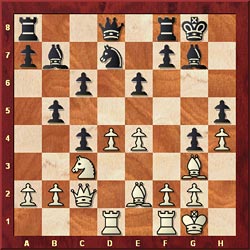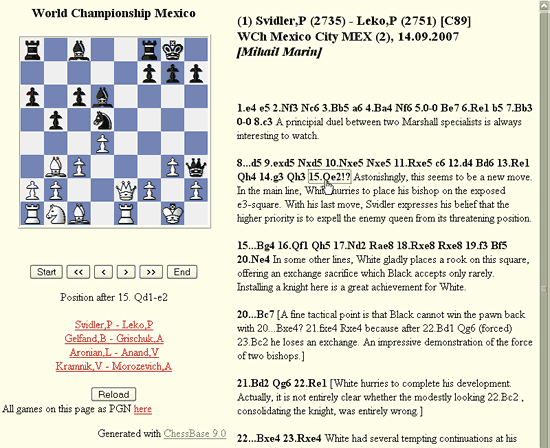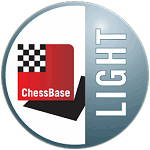


ChessBase 17 - Mega package - Edition 2024
It is the program of choice for anyone who loves the game and wants to know more about it. Start your personal success story with ChessBase and enjoy the game even more.

The World Championship 2007 will take place from September 12 to 30 in the Sheraton Centro Histórico Hotel in Mexico City. Eight players are qualified – the tournament will be a double round robin. The prize fund is US $1.3 million.
A very exciting round, with sharp battles and two decisive games. Grischuk employed a relatively rare opening plan with Black against Gelfand, who found nothing better than carrying out a tactical operation resulting in simplifications and a peaceful result. Svidler delivered a surprisingly early novelty against Leko's Marshall Attack, but later failed to take advantage of what seemed to be a favourable situation.
Anand also opened a new theory file against Aronian, by exploiting in creative way the dark side of a well approved white plan. The Armenian star tried to solve his problems by tactical means, but Anand's accurate reaction left him in a joyless position. Aronian resigned after the first time control.
The star game of the evening was Kramnik-Morozevich. The World Champion gradually tempted his opponent to grab material at the cost of neglecting his development. Morozevich abstained himself on the first occasion, but then kindly obliged and the position became highly irrational. Kramnik emerged out of the complications with a clear advantage, but immediately after that offered to his opponent a chance to come back into the game. Morozevich missed his chance and went down quickly.

Our commentator and chess teacher GM Mihail Marin
Svidler,P (2735) - Leko,P (2751) [C89]
WCh Mexico City MEX (2), 14.09.2007 [Mihail Marin]
1.e4 e5 2.Nf3 Nc6 3.Bb5 a6 4.Ba4 Nf6 5.0-0 Be7 6.Re1 b5 7.Bb3 0-0 8.c3. A principial duel between two Marshall specialists is always interesting to watch. 8...d5 9.exd5 Nxd5 10.Nxe5 Nxe5 11.Rxe5 c6 12.d4 Bd6 13.Re1 Qh4 14.g3 Qh3.



White has won a pawn, but Black's centralized army as well as the firm control on light squares offers him good saving chances. Besided, the white king is passive and slightly exposed. 36.Bf2 Bd6 37.c4 bxc4 38.bxc4 Bc7 39.d5 cxd5 40.cxd5 Bd6 41.a4 Qb1+ 42.Kg2 Qf5 43.Kg1 1/2-1/2. [Click to replay]
Gelfand,B (2733) - Grischuk,A (2726) [E15]
WCh Mexico City MEX (2), 14.09.2007 [Mihail Marin]
1.d4 Nf6 2.c4 e6 3.Nf3 b6 4.g3 Ba6 5.b3 Bb7. From the spectator's point of view, a refreshing deviation from the ultra-fashionable 5...Bb4+ 6.Bd2 Be7. 6.Bg2 Bb4+ 7.Bd2 c5. The other possible attempt to take advantage of the slight weakness induced by the move b3 is 7...a5. 8.Bxb4 cxb4



18...b5!? Grischuk refrains from the standard way of ensuring stability to his knight, 18...a5 , because this would have allowed White to activate the other rook as well. Instead, the tactical operation initiated with his last move will lead to mass simplifications and a comfortable position for Black. 19.Rxc6. Forced. The generally desirable 19.Rc5? , installing the rook on an apparently comfortable square, would lose material to 19...Nxd4! attacking not only the rook, but also the queen (in view of the threat Ndxe2+). 19...Rxc6 20.Ng5 Qxg5 21.Bxc6 Rc8 22.Bb7 Rc7 23.axb4. After 23...Nxe2+ 24.Qxe2 Rxb7 25.Qe4, White's piece activity compensates for his slightly worse pawn structure. 1/2-1/2. [Click to replay]
Aronian,L (2750) - Anand,V (2792) [D43]
WCh Mexico City MEX (2), 14.09.2007 [Mihail Marin]
1.d4 Nf6 2.c4 e6 3.Nf3 d5 4.Nc3 c6 5.Bg5 h6 6.Bh4 dxc4 7.e4 g5 8.Bg3 b5. An excellent way to play for a win with Black, although it should be said that White's cooperation is needed, too. In case of 6.Bxf6 (as played just one day earlier by Kramnik against Svidler), play takes a positional course. However, Aronian is not the kind of player to refrain from a sharp battle, especially when he has the white pieces. 9.Ne5 h5 10.h4 g4


17.f3. This move is almost unanimously played here. White finally establishes a centre of pawn tension and aims to open the f-file for his king's rook. The only (but significant) drawback of this move is that it weakens the king's residence. 17...c5!? An interesting novelty. Previously, 17...Qb6 was considered best. Anand decides that the best way of taking advantage of the vulnerability of the enemy king is to keep the queen on her initial square. 18.dxc5. The generally desirable 18.d5 can be strongly met by 18...Be5! when White is in some sort of trouble: 19.Bxe5?! (After 19.f4 Bd4+ the black dark-squared bishop is much more active than his direct rival.) 19...Nxe5 20.f4? Qxh4! with decisive attack. 18...Qe7 19.Kh1 a6 20.a4 Bc6. Black has stabilized the position and threatens to win the c5-pawn with ...Nxc5. Since 21.Rd6 can be strongly met by 21...Be5!, White is forced to resort to radical measures.

1.Nd5!? exd5 22.exd5. Normally, this kind of operation would yield White an advantage... 22...Be5! ... but only with a safer king's position! With this already familiar to us move, Anand forces his opponent to release the kingside tension and consolidates his advantage. 23.f4 Bg7 24.dxc6 Nxc5 Both White's bishops are very passive. The c6-pawn in conjunction with certain rook activity along the d-file will prove insufficient to level the balance. 25.Rd5 Ne4 26.Be1 Qe6 27.Rxh5 f5

White has temporarily won a pawn, but his rook is miserably placed. Anand went on winning convincingly. 28.Kh2 Rac8 29.Bb4 Rfe8 30.axb5 axb5 31.Re1 Qf7 32.Rg5 Nxg5 33.fxg5 Rxc6 34.Bf1 Rxe1 35.Bxe1 Re6 36.Bc3 Qc7+ 37.g3 Re3 38.Qg2 Bxc3 39.bxc3 f4 40.Qa8+ Kg7 41.Qa6 fxg3+ 0-1. [Click to replay]
Anand: "The game revolved around this move 17...c5. It's a very interesting idea. We found it just here – Nielsen suggested it about three days ago. Sometimes if you can surprise your opponent it is worth almost as much as making a lot of good moves, because he has to deal with a lot of problems over the board. He played 21.Nd5 fairly quickly, and I think he missed this plan of 22...Be5 and 23...Bg7, or he underestimated it, I don't know which. As you can see, in the whole game I am playing against this bishop on e2 – my pawns on h5 and g4, and b5 and c4 control this bishop. This turned out to be the deciding factor in the game."
Kramnik,V (2769) - Morozevich,A (2758) [E04]
WCh Mexico City MEX (2), 14.09.2007 [Marin,Mihail]
1.Nf3. When Kramnik played this move in the previous round, I thought he might have just wanted to avoid Svidler's Grünfeld. Now, it seems that he really switched back to the favourite weapon of his youth. 1...Nf6 2.c4 e6 3.g3 d5 4.d4. However, the Catalan is a relatively recent "discovery" of Kramnik and his results with it have been excellent. Apparently, the subtle combination of tactical and strategic motifs suits his talent quite well. This game is an excellent illustration. 4...dxc4 5.Bg2 a6 6.Ne5. The more ambitious continuation is supposed to be 6.0-0 . The text move is considered to offer Black an equal game after 6...c5, but both Morozevich and Kramnik seem to have a different opinion... 6...Bb4+ 7.Nc3 Nd5




Now it's all over. These pawns cannot be stopped. 22...Nxb6 drops a piece to 23.Qc6, while Morozevich' desperate (but delayed!) counterplay cannot change anything. 22...Ne5 23.Bxe5 Qf3 24.Qd1 Qe4 25.b7 Rf8 26.c8Q Bd5 27.f3 1-0. [Click to replay]
Note that on our JavaScript replay page, to which we link after each game, you can follow the moves by clicking on them – even in variations and analysis. The board will follow.

You can scroll the moves and commentary on the right using the scroll bar or your mouse wheel. The four games are listed on the left and can be loaded by clicking them. There is also a PGN download, which will get you the games with full commentary, to replay and analyse in Fritz or a compatible program, including the free ChessBase Light (download link given below).

 |
|